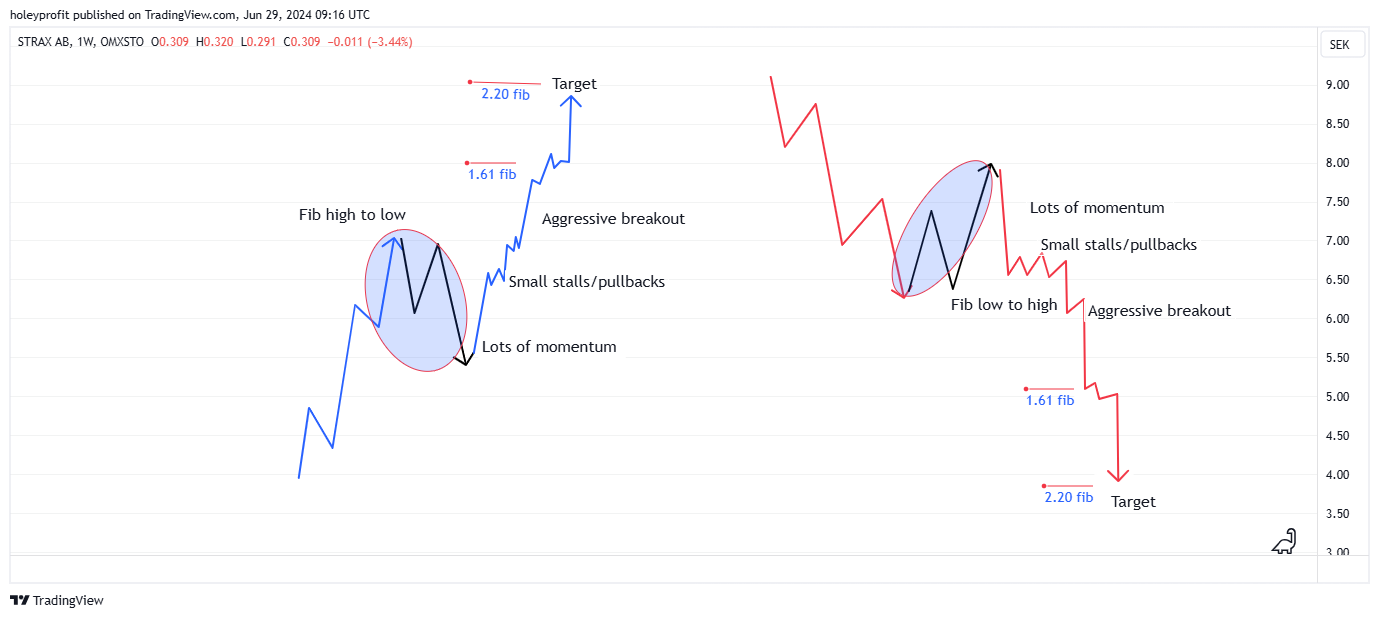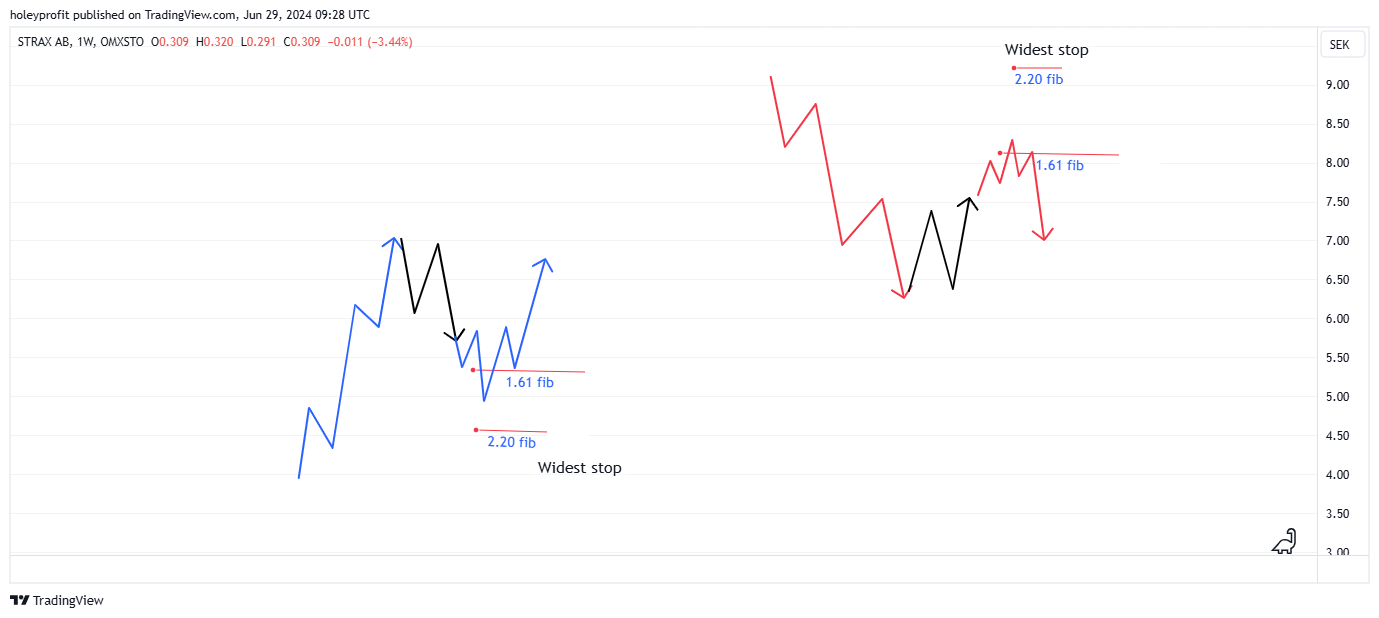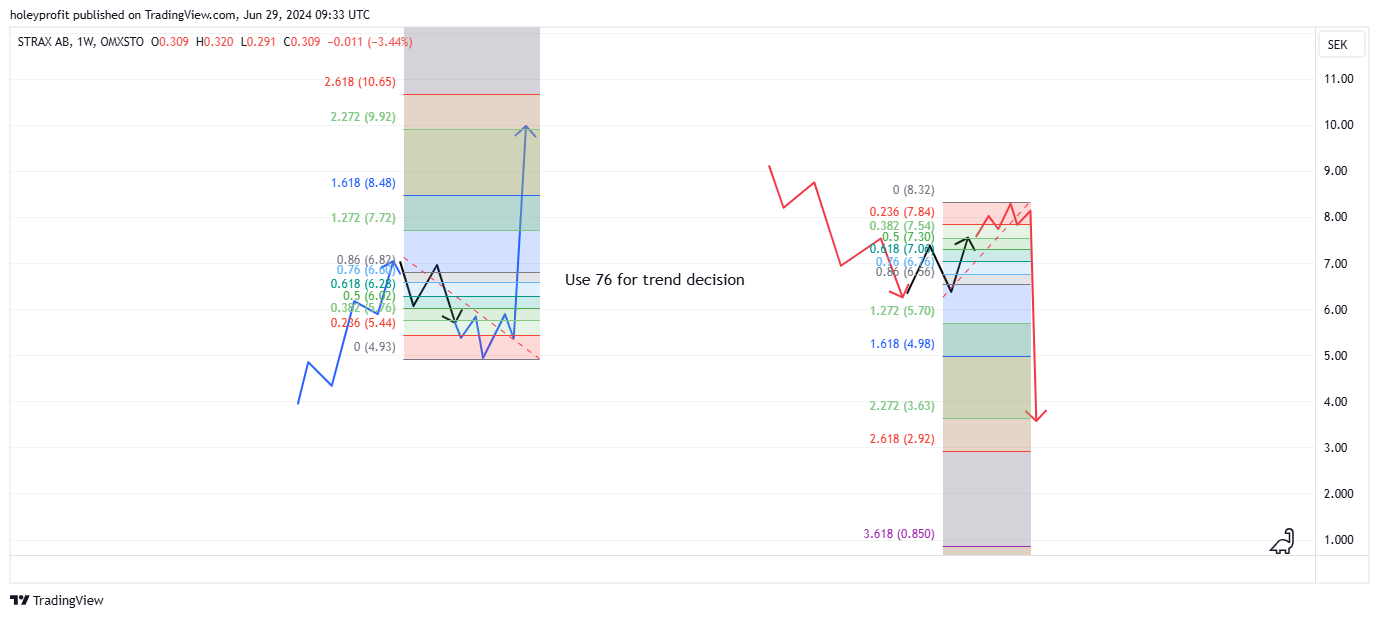This is part of a series of strategy posts.
Once all strategy posts are up, they will be linked together. Initially there will be placeholders for links - Marked “(Link)”. This is because all posts need to be published to be able to interlink them. Please check back later for complete interlinking.
The original series of posts will contain 15 strategies. All of them time tested and ones I’ve personally used to make a living in markets for over 10 years. These will all be free. Multiple additional posts will be added for paid members. Discussing advanced strategy, nuances and covering the common questions we’d expect about the strats.
You can join as a paid member for only $15.
Strategy Name:
- Butterfly Correction Pattern in a Trend
Strategy Type:
- Trend Continuation Following a Correction
Strategy Premise Overview:
- The Butterfly Correction Pattern in a Trend strategy identifies correction phases within persistent trends, leveraging the harmonic butterfly pattern to capture continuation moves.
-This strategy focuses on the two-leg correction, providing opportunities for trend-following trades after aggressive trend corrections.
-This strategy particularly looks to spot very early when an unusually strong trend move is setting up and to get into that very early.
Conditions for Use:
- This strategy is for use inside of a developing trend. The market should have a clear sense of direction.
-There are multiple conditions for this strategy to fire. First we need to see a pullback against the trend. Then it started to attempt to make a trend continuation. Usually there will have been many successful versions of this trend continuation pattern recently and this will feel like “Business as usual” for the trend - but no new breakout is made.
- A sharp second corrective leg comes. Spiking out the previous correction. This will have formed a “M” shape if we were uptrending and a “W” shape if we were downtrending.
-The corrective swings of the butterfly are shown in black below.
-When these conditions are met, we can map out the potential harmonic pattern and plan our trades.
Planning Entries:
-This pattern can be anticipated as a big correction pattern at an important level but if you’re using a trend continuation strategy you’re commonly going to run into a failed signal on that in this section.
- Often here this can be a 76 retracement in the pullback but fail to make a new high/low. Generating losing versions of the 76 trade.
- Once there’s been a double bottom/top and a breakout we can draw an extension fib on the BC leg. Our entry zone in the 1.61 area.
- Limit orders can be placed for the 1.61.
- Alternatively, price action based signals can be used if there is a reaction around the 1.61. For example, it’s common to see a head and shoulders where there’s first a reaction from 1.61, then there’s a spike over the 1.61 and then the right shoulder is a 1.61 retest.
Planning Stops:
- Stop here is no wider than behind the 2.20 fib. Although book rules say the butterfly can end in the 1.61 - 2.61 zone I find most of the time when 2.20 hits 2.61 will hit. No point hanging around. I can try again at 2.61 if I want to. Failure of this pattern can lead to strong counter moves (Link). 2.20 breaks are where things go from bad to worse in those cases.
- Tighter stops can be used with price action. As with the head and shoulders example. This greatly increases the RR potential but also will increase the amount of times you get wicked out just before the real move.
Planning Targets:
- As mentioned at the start, this strategy aims to catch really great trades. When we’re trading the butterfly correction in a trend we’re looking for this to be the middle of the trend (At worst). When we get good entries we should be patient with our trades. It’s worth targeting big and trailing stops on this setup.
- Default target for this move is 2.20 extension of the CD leg of the harmonic. This will be a big move relative to the amount risked at the 1.61 entry point. Trailing stops more and more aggressively as we get close to there is optimal (It might break) but this is the passive target.
Typical Win Path:
- When this trade comes we are looking at something sensational. Everything about it is sensational. Usually the trend before has been impressive. The D leg spike out is a dramatic move and feels a lot like a trend reversal - and the failure of this reversal and trend continuation is sensational in its strength.
- One of the notable traits of this setup is there are few deep pullbacks. Trailing stops behind local structures will usually do a good job of keeping you in the trade.
- The move into the 2.20 area will most often be expressed as a parabolic jump or a crash, depending on direction. The previous high/low will be broken. It will feel “Overbought/sold” and then it accelerates.
Typical Lose Path:
- The loss path for this setup is equally sensational. When this signal fails as a continuation pattern it often marks a trend reversal.
- Read the counter strategy for when this fails here. (Link).
Why Strategy is Expected to be Successful:
- The strategy leverages the harmonic butterfly pattern as a correction phase within a larger trend, capturing trend continuation moves.
- Provides clear entry and exit points based on Fibonacci extensions, allowing for precise risk management and favorable risk-reward ratios.
- When the trade works, it is excellent pain free trade. It runs smoothly and allows you to capture the full RR potential.
-Instances of successful versions of this trade are not exceptionally common but that is more than compensated for by how well they pay off when they work. Combined with the fact a complex set of swings required to generate the signal mean there are not too many false signals and if there are false signals, it’s usually easy to recover losses using the counter strategy (Link).
Known Risks and Weaknesses:
- When betting on this strategy you’re planning to enter into a D leg. D legs are known to be exceptionally strong. So if you’re betting on a D leg you expect to see all sorts of crazy momentum against you. Sometimes, all that momentum is actually for a good reason - but the rules of strategy have you embrace all strength as part of the signal.
- Some of the best trend continuation moves come off of this signal. When it fails, it can commonly denote trend failure (Link).
Trade Plan Execution:
Bullish Execution Plan:
Step 1: Market Analysis
Identify a developing uptrend with clear directional movements and recent successful trend continuation patterns.
Confirm the trend direction by analyzing higher highs and higher lows.
Look for a pullback against the trend followed by an attempted trend continuation that fails to make a new breakout (Double top).
Step 2: Identify Entry Points
Spot a failure of higher highs. Some sort of double top like move.
When there’s a break of previous high, draw the fib.
Draw Fibonacci extension levels on the BC leg of the harmonic pattern.
Step 3: Invalidation Alert
Set alerts where the harmonic structure would become invalid. That scraps this setup and requires fresh analysis.
Step 4: Set Alert
Set an alert slightly past the 1.61 Fibonacci extension level to notify you when the price approaches this key level.
Step 5: Confirmation and Entry
Limit orders can be set at the 1.61 (Note, there will most often be a spike out of the 1.61 and limit orders can also be set a bit above it).
Usually we’ll get some sort of complex candle pattern like a a head and shoulders to take trades on the retest of the 1.61.
Step 6: Place Stop Loss
Set a stop loss slightly below the 2.20 Fibonacci extension level.
Alternatively, use tighter stops based on price action and recent local swing lows for higher RR potential.
Step 7: Manage Trade
When we get a good reaction off this trade the question becomes whether this is a retracement in a new bearish trend or the continuation of the existing bull trend. Our best way to determine one from the other is to use the 76 Continuation or Failure rules. Trailing stops as we get close to the 76 level.
Expect minimal deep pullbacks and trail stops behind local structures to stay in the trade.
Step 8: Set Targets
Target the 2.20 Fibonacci extension level of the CD leg of the harmonic pattern.
Use trailing stops to manage the trade as it approaches the target area to capture potential parabolic moves.
Bearish Execution Plan:
Step 1: Market Analysis
Identify a developing downtrend with clear directional movements and recent successful trend continuation patterns.
Confirm the trend direction by analyzing lower lows and lower highs.
Look for a pullback against the trend followed by an attempted trend continuation that fails to make a new breakdown (Double bottom).
Step 2: Identify Entry Points
Spot a failure of lower lows. Some sort of double bottom-like move.
When there’s a break of previous low, draw the Fibonacci extension levels on the BC leg of the harmonic pattern.
Step 3: Invalidation Alert
Set alerts where the harmonic structure would become invalid. This scraps the setup and requires fresh analysis.
Step 4: Set Alert
Set an alert slightly past the 1.61 Fibonacci extension level to notify you when the price approaches this key level.
Step 5: Confirmation and Entry
Limit orders can be set at the 1.61 Fibonacci extension level (Note: there will often be a spike out of the 1.61, so limit orders can also be set a bit below it).
Usually, we’ll get some sort of complex candle pattern, like a head and shoulders, to take trades on the retest of the 1.61.
Step 6: Place Stop Loss
Set a stop loss slightly above the 2.20 Fibonacci extension level.
Alternatively, use tighter stops based on price action and recent local swing highs for higher RR potential.
Step 7: Manage Trade
When we get a good reaction off this trade, the question becomes whether this is a retracement in a new bullish trend or the continuation of the existing bearish trend.
Use the 76 Continuation or Failure rules to determine the nature of the trend.
Trailing stops as we get close to the 76 level.
Expect minimal deep pullbacks and trail stops behind local structures to stay in the trade.
Step 8: Set Targets
Target the 2.20 Fibonacci extension level of the CD leg of the harmonic pattern.
Use trailing stops to manage the trade as it approaches the target area to capture potential parabolic moves.






















